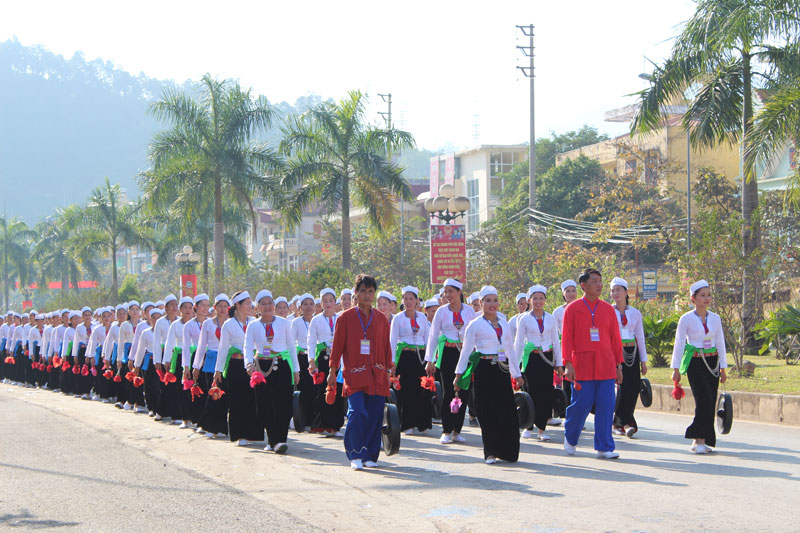
HBO – As of June 2018, the ethnic minority groups in Hoa Binh province owned a total of 786 intangible cultural heritages, according to statistics of the provincial Department of Culture, Sports and Tourism. More than ever, the preservation and promotion of heritage values need due attention.

Artists
perform at second Muong gong festival
Hoa Binh is home to six ethnic groups with their own cultural
characteristics, which helps form a diverse, unique and impressive culture of
Hoa Binh.
Basically, the local ethnic groups still maintain their
traditional customs. The values of heritages related to literature, spoken language
and handwriting (excluding Muong ethnic group) are conserved, while folk
knowledge and traditional costumes are kept at an average level. For example,
Muong people’s cultural values such as folk singing, gong art, and epic are well
preserved and appreciated. Stilt houses are fading away, but many localities
such as Lac Son and Tan Lac are building stilt houses using concrete instead of
wood as usual. Meanwhile, Tay people still keep their folk songs and maintain
the teaching and learning of ancient handwriting in the community. The Dao
ethnic group continues maintaining "cap sac” (maturity ritual), Tet nhay
(dancing ceremony), and ancient handwriting study, while Mong people still
preserve their costumes, housing architecture, forging, language, Tet (new
year) festival and khen (panpipe) festival.
Notably, some positive signs have been seen in recent time,
including the development of traditional festivals and Muong gong. The role of
Muong shamans has been improved in society.
Localities have paid attention to and invested in preserving and
promoting the values of intangible cultural heritages through the formation of
one traditional cultural village, dozens of community-based tourism cultural
villages at the provincial level, as well as the implementation of nearly 30
scientific projects on culture and ethnic groups, the organization of nearly 50
classes to teach folk arts, hundreds of classes on ancient handwriting, and the
restoration of 50 traditional festivals.
As of June, five ethnic minority groups in the province owned 786
intangible cultural heritages, including spoken language, handwriting,
literature, folk performance art, traditional festivals, handicrafts and folk
knowledge.
The provincial Party Committee and People’s Committee allowed to
collect, study and make scientific documents for two intangible cultural
heritages: Mo Muong and Muong gong, and consider the use of Muong alphabet. The
province will continue making a document on Mo Muong to submit to UNESCO in
order to seek its recognition as the Intangible Cultural Heritage in Need of Urgent
Safeguarding./.
With an increasingly vibrant and widespread emulation movement aimed at building cultured residential areas and cultured families, Yen Thuy District has been making steady progress toward improving both the material and spiritual well-being of its people, while fostering a civilized, prosperous, beautiful, and progressive community.
Once lacking recreational spaces and community facilities, Residential Group 2 in Quynh Lam Ward (Hoa Binh City) has recently received attention for the construction of a new, spacious, and fully equipped cultural house. The project followed the model of state support combined with public contributions in both labor and funding.
The "All people unite to build cultural life" movement, which has been effectively integrated with Kim Boi district’s socio-economic development goals, is fostering a lively spirit of emulation across local residential areas, hamlets, villages, public agencies, and enterprises. In addition, through the initiative, traditional cultural values are being preserved and promoted, while community solidarity and mutual support in poverty reduction and economic development are being strengthened.
A working delegation of the Hoa Binh provincial People’s Committee led by its Permanent Vice Chairman Nguyen Van Toan on June 11 inspected the progress of a project to build the Mo Muong Cultural Heritage Conservation Space linked to tourism services in Hop Phong commune, Cao Phong district.
Born and growing in the heroic land of Muong Dong, Dinh Thi Kieu Dung, a resident in Bo town of Kim Boi district, in her childhood was nurtured by the sweet lullabies of her grandmother and mother. These melodies deeply imprinted on her soul, becoming an inseparable part of her love for her ethnic group's culture. For over 20 years, this love for her hometown has driven Dung to research, collect, and pass down the cultural values of the Muong people to future generations.
In the final days of May, the Ethnic Art Troupe of Hoa Binh Province organized performances to serve the people in remote, mountainous, and particularly disadvantaged areas within the province. These were not just ordinary artistic shows, but they were the meaningful journeys aimed at spreading cultural values, enhancing the spiritual life of the people and contributing to the preservation of ethnic minority cultural identities.



